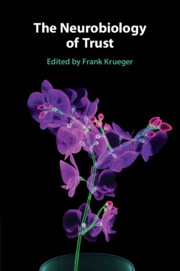Book contents
- The Neurobiology of Trust
- The Neurobiology of Trust
- Copyright page
- Dedication
- Contents
- Figures
- Tables
- Contributors
- Abbreviations
- Introduction
- Part I Fundamental Level of Trust
- Part II Neuropsychological Level of Trust
- Part III Neurocharacteristic Level of Trust
- Part IV Neuromolecular Level of Trust
- Chapter 13 Trust and Oxytocin
- Chapter 14 Trust and Psychopharmaca:
- Chapter 15 Trust and Genetics
- Part V Neuropathological Level of Trust
- Index
- References
Chapter 15 - Trust and Genetics
Genetic Basis of Trust Behavior and Trust Attitude
from Part IV - Neuromolecular Level of Trust
Published online by Cambridge University Press: 09 December 2021
- The Neurobiology of Trust
- The Neurobiology of Trust
- Copyright page
- Dedication
- Contents
- Figures
- Tables
- Contributors
- Abbreviations
- Introduction
- Part I Fundamental Level of Trust
- Part II Neuropsychological Level of Trust
- Part III Neurocharacteristic Level of Trust
- Part IV Neuromolecular Level of Trust
- Chapter 13 Trust and Oxytocin
- Chapter 14 Trust and Psychopharmaca:
- Chapter 15 Trust and Genetics
- Part V Neuropathological Level of Trust
- Index
- References
Summary
Are individual differences in trust subject to genetic influences? If possibly heritable, which specific gene is associated with trust? This chapter reviews previous studies to answer these questions and introduces the genetic basis of trust, including trust behavior and trust attitude. In twin studies, trust was demonstrated to be influenced by genes to some degree (about 10%–20% in trust behavior and above 30% in trust attitude). To determine which specific gene is associated with trust, researchers used molecular biological techniques to determine the genetic polymorphisms of specific genes and examine the relationship between trust and genes. Thus far, it has been found that the oxytocin receptor gene, arginine vasopressin receptor 1A gene, dopamine D4 receptor gene, and serotonin transporter gene are associated with trust level. In this chapter, we will introduce these genes and the relationship between trust and genes.
- Type
- Chapter
- Information
- The Neurobiology of Trust , pp. 369 - 386Publisher: Cambridge University PressPrint publication year: 2021



